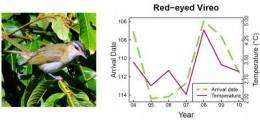Geographic variation in phenological response and example trajectories of temperature and arrival date. Credit: Hurlbert AH, Liang Z (2012) Spatiotemporal Variation in Avian Migration Phenology: Citizen Science Reveals Effects of Climate Change. PLoS ONE 7(2): e31662. doi:10.1371/journal.pone.0031662
Bird migration timing across North America has been affected by climate change, according to a study published Feb. 22 in the open access journal PLoS ONE.
The results are based on a systematic analysis of observations from amateur birdwatchers. This citizen science approach provided access to data for 18 common North American bird species, including orioles, house wrens, and barn swallows, across an unprecedented geographical region.
The researchers, led by Allen Hurlbert of University of North Carolina, Chapel Hill, found that the average arrival time for all species and all locations was shifted earlier by almost a full day for every degree Celsius of warming of the spring temperature, and some species shifted their arrival time by as much as 3-6 days per degree. These results highlight both the power of citizen science for obtaining data, and the potential important impacts of climate change on migration patterns.
"We now have a much better idea of which parts of the country are seeing big shifts in migration timing, and which species may be least able to adapt to the changing climate", says Dr. Hurlbert.
More information: Hurlbert AH, Liang Z (2012) Spatiotemporal Variation in Avian Migration Phenology: Citizen Science Reveals Effects of Climate Change. PLoS ONE 7(2):e31662. doi:10.1371/journal.pone.0031662
Journal information: PLoS ONE
Provided by Public Library of Science




















